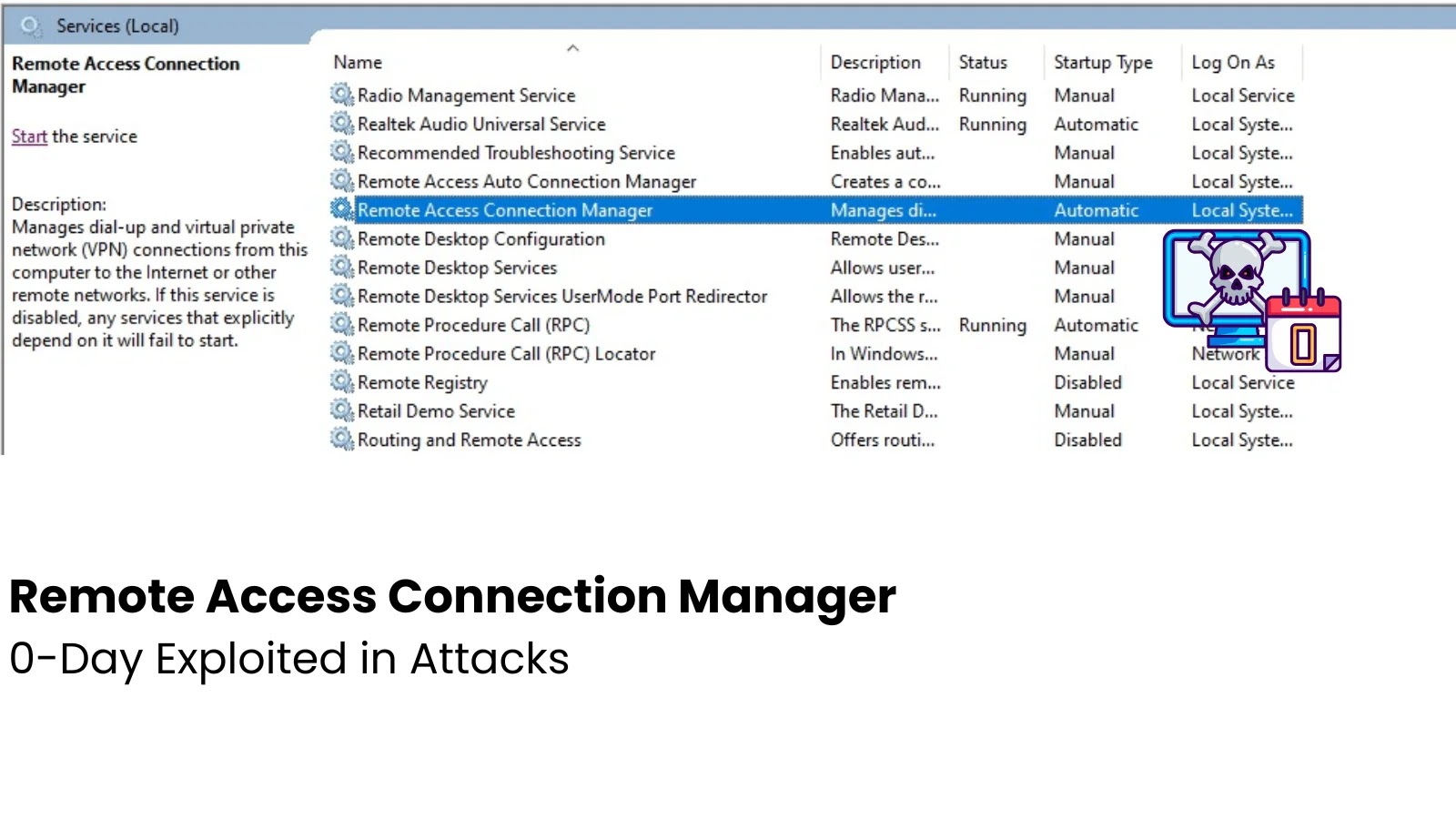
Windows Remote Access Connection Manager 0-Day Vulnerability Actively Exploited in Attacks
Urgent Alert: Windows Remote Access Connection Manager Zero-Day Actively Exploited
A critical zero-day vulnerability in the Windows Remote Access Connection Manager (RasMan) service is currently under active exploitation, posing a significant risk to organizations worldwide. Microsoft has confirmed that this flaw, tracked as CVE-2025-59230, allows attackers to escalate privileges, potentially leading to full system compromise. This urgent development demands immediate attention from IT administrators and cybersecurity professionals.
Understanding the RasMan Zero-Day Vulnerability: CVE-2025-59230
The CVE-2025-59230 vulnerability resides within the Windows Remote Access Connection Manager (RasMan) service. This service is integral to managing virtual private network (VPN) connections and dial-up networking in Windows environments. The flaw itself is a classic case of improper access control, enabling a low-privileged local user to elevate their privileges to SYSTEM-level. SYSTEM-level access grants an attacker complete control over the affected machine, allowing them to install programs, view, change, or delete data, or create new accounts with full user rights.
The disclosure of this vulnerability on October 14, 2025, by Microsoft, confirmed the active exploitation in the wild. This means that malicious actors are already leveraging this weakness to gain unauthorized access and control over vulnerable systems. The implications are severe, as many organizations rely heavily on Windows devices, making a broad range of systems susceptible to this privilege escalation technique.
How the RasMan Zero-Day Poses a Threat
Active exploitation of a privilege escalation vulnerability like CVE-2025-59230 presents a clear and present danger:
- Full System Compromise: Once an attacker gains SYSTEM privileges, they can execute arbitrary code, modify system configurations, and deploy malware such as ransomware or rootkits without further restrictions.
- Lateral Movement: An attacker with SYSTEM access on one machine can often use it as a pivot point to move laterally across the network, compromising other systems and services.
- Data Exfiltration: With full control, sensitive data stored on the compromised system can be easily exfiltrated, leading to significant data breaches and regulatory penalties.
- Persistent Access: Attackers can establish persistent backdoors, ensuring continued access even after initial compromise attempts are detected and remediated.
Remediation Actions and Mitigations
Given the active exploitation of CVE-2025-59230, immediate action is paramount. While Microsoft has confirmed the vulnerability, a patch is still pending. Until an official patch is released, organizations must implement proactive mitigation strategies:
- Apply Security Updates Promptly: As soon as Microsoft releases a security update addressing CVE-2025-59230, prioritize its deployment across all affected Windows systems. Follow a robust patch management policy.
- Implement Principle of Least Privilege: Ensure all user accounts and service accounts operate with the minimum necessary permissions. Review and restrict elevated privileges wherever possible. This limits the impact of a successful privilege escalation.
- Strengthen Endpoint Detection and Response (EDR): Utilize EDR solutions to monitor for suspicious activity, especially attempts at privilege escalation, unauthorized process creation, or unusual network connections. Configure alerts for such events.
- Network Segmentation: Isolate critical systems and sensitive data using network segmentation. This can help contain the spread of an attack even if a system is compromised.
- Regular Security Audits: Conduct frequent security audits and vulnerability assessments to identify and address weaknesses in your infrastructure.
- User Training: Educate users about phishing and social engineering tactics, which are often used to gain initial access to a low-privileged account that could then be exploited via this zero-day.
Tools for Detection and Mitigation
Leveraging appropriate tools is crucial for identifying potential compromises and strengthening your defensive posture against vulnerabilities like CVE-2025-59230.
| Tool Name | Purpose | Link |
|---|---|---|
| Microsoft Defender for Endpoint | Advanced endpoint detection and response (EDR), behavioral monitoring. | https://www.microsoft.com/en-us/security/business/threat-protection/microsoft-defender-for-endpoint |
| Sysmon | Detailed logging of system activity, process creation, network connections. | https://learn.microsoft.com/en-us/sysinternals/downloads/sysmon |
| PowerShell Reverse Engineering (PRE) | Analyzing suspicious PowerShell scripts for privilege escalation attempts. | https://github.com/dchristl/pre |
| Nessus | Vulnerability scanning for identifying unpatched systems and misconfigurations. | https://www.tenable.com/products/nessus |
Key Takeaways for Cybersecurity Professionals
The active exploitation of the Windows Remote Access Connection Manager zero-day (CVE-2025-59230) underscores the persistent threat posed by privilege escalation vulnerabilities. Organizations must act decisively to secure their environments. Prioritize the application of the principle of least privilege, enhance endpoint monitoring, and prepare for rapid deployment of the upcoming security patch from Microsoft. Vigilance and proactive security measures are critical to protecting against this and future zero-day attacks.





